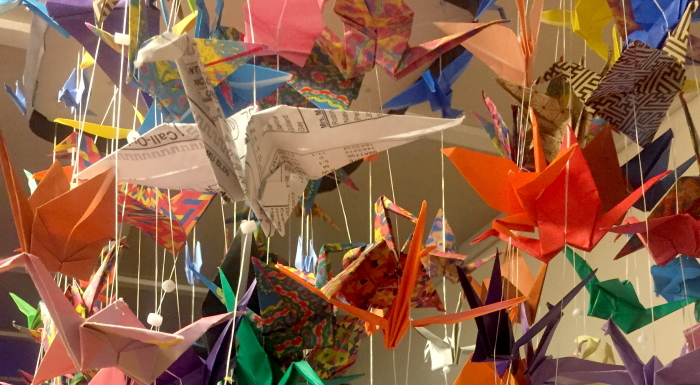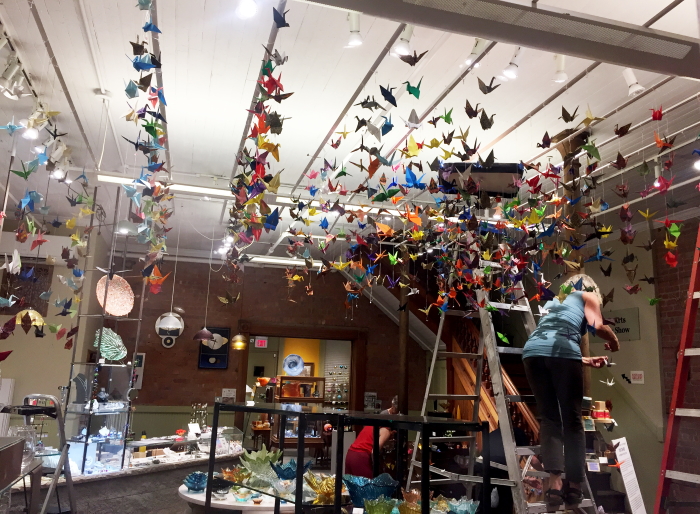Beacon inmates fold cranes for exhibit
By Alison Rooney
For the last week, Hudson Beach Glass in Beacon has been home to 1,000 cranes.
They are origami cranes, constructed by inmates at the Fishkill Correctional Facility in Beacon as part of a visual arts program.
The cranes will remain in flight until Sept. 29, but a reception will take place on Saturday, Aug. 17, from 5 to 7 p.m. A representative from Rehabilitation Through the Arts (rta-arts.org) will speak briefly about its prison projects, which also include theater, music and dance.

As with other RTA programs, the visual art classes are run by volunteers. Michael Dwyer, who specializes in putting art into public places, launched the class at the medium-security prison about a year ago. He travels to Beacon each Monday from his home in White Plains, co-teaching with an inmate whom he discovered was a “super-talented” artist.

The program has provided prisoners with instruction on topics such as landscapes, self-portraits, logos, storyboarding and fashion design. Many projects culminate in an exhibit such as the one at Hudson Beach Glass.
Knowing that many people find Japanese paper-folding to be meditative, Dwyer suggested the form to his students. “We started with cups, boats and animals,” he recalls, “Then I told them the story of the cranes.”
According to Japanese legend, anyone who folds 1,000 origami cranes will be granted a wish by the gods. It was popularized by Sadako Sasaki, a girl from Hiroshima who died of leukemia linked to the dropping of the atomic bomb and who, while hospitalized, folded cranes after her father told her the story. A statue of Sasaki holding a golden crane is in the Hiroshima Peace Memorial Park.
“I told the guys: ‘If you do 1,000, my job will be to find a place to exhibit them.’ My goal was always to do it in Beacon, for proximity and as an acknowledgement that they are part of the community, yet probably not thought about that much,” Dwyer says.
With the visual arts, Dwyer explains, many students want to do traditional drawing. Some struggled with origami but “the guys teach each other, and pitch in if someone has missed a class. They even taught guys outside class. The atmosphere is supportive. It’s different from what people think prison would be. Not everyone there can do this — they have to apply, they’re appreciative. There are no discipline issues.”

Dwyer says a goal of his class is to “be able to treat these guys like human beings, even though they’ve made mistakes. The goal is to restore some of their humanity. We can’t let them be defined just by what they did, or they’d have no future. The space is supportive and recognizes them as individuals, and creative beings. Through the art they can work through some of their personal challenges and develop perseverance and commitment.”
One participant, Hector Lopez, who has been released and lives in the Bronx, plans to attend the Aug. 17 reception, Dwyer says, and family members of the prisoners have been invited. Although the inmates can’t attend, Dwyer plans to put out a guest book so he can “communicate the reactions to their art back to them.”
Hudson Beach Glass is located at 162 Main St. in Beacon. It is open Monday to Saturday from 10 a.m. to 6 p.m. and Sunday from 11 a.m. to 6 p.m.

